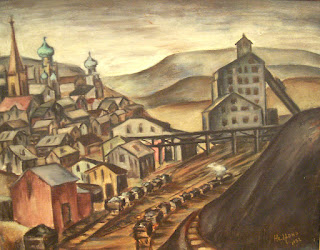The
exhibition, Angelo Pinto, A Retrospective, 1928 to 1987: Paintings, Drawings,
and The Complete Prints, is at the Susan Teller Gallery, October 6 through
November 8, 2012. Concurrently the Gallery is publishing Angelo Pinto: The
Complete Prints, with essays by Maria Pinto Carland, Richard J. Wattenmaker,
and Susan Teller.
The entire show may be viewed at:
The
career of Angelo Pinto (1908-1994) spans more than six decades, from the late 1920s just to
the 1990s. A painter, printmaker, draftsman, photographer, teacher, collagist,
and stage and costume designer, he was a highly innovative artist who also
revived the ancient technique of painting on glass.
 |
Angelo Pinto, The Circus Room (also titled
The Magic Room), 1974 |
Born in Casal Velino, Italy, Angelo Pinto came to
America as an infant and grew up in Philadelphia. He graduated from the
Pennsylvania Museum School of Industrial Art (now the University of the Arts,
Philadelphia), in 1929. In 1928 he began classes at the Barnes Foundation
(eventually his four brothers attended as well); it was an association that
would last for the rest of his life.
The inventor and philanthropist Dr. Albert C. Barnes
(1872-1951), an early collector of Angelo’s work, subsidized his three European
trips, 1931, 32, and 33, and he even traveled with Angelo and his brothers
Salvatore and Biagio. In France they visited the artist Henri Matisse who
suggested they also visit Corsica and Morocco. Angelo taught art at the Barnes
Foundation from 1935 until 1992, and was their official photographer until his
death in 1994.
The late 20s and early 30s were intensive years of
painting and printmaking. Works from this period reflect Pinto’s traditional
art education, his exposure to Modernism, his travels, and his meeting with
Matisse. They also reveal his interest in the theatre and the fantasylands of
parks, carnivals, and boardwalks -- sometimes bizarre worlds that veer into the
surreal.
 |
| Angelo Pinto, The Shooting Gallery, 1935 |
In 1929 Pinto’s Red Water Lily was shown in the 9th
International Exhibition of Water Color Painting at the Art Institute of
Chicago. The first major showing of his work in 1930, with Salvatore, at both
the Philadelphia Print Club and the Kleeman-Thorman Galleries, New York City,
was dedicated to etchings. There were also joint shows at the Mellon Galleries,
Philadelphia, 1932, Bignou Gallery, Paris, 1933, and the Valentine Gallery,
NYC, 1937.
Work by Angelo Pinto was shown in the American Block
Prints Annuals of the 1930s at the Print Club of Philadelphia, in One Hundred
Contemporary American Prints, Weyhe Galleries, 1931, in the Second Biennial
Exhibition of Contemporary Painting at the Whitney Museum of American Art,
1935, in American Paintings and Sculpture, 47th Annual Exhibition,
Art Institute of Chicago, 1936, and at the New York World’s Fair, 1939.
In the mid-1930s Pinto and his brothers established
a commercial photography studio in New York City. They pioneered the field of
location color photography and their work was featured in Town & Country,
Life, and Look magazines. In 1941 Angelo, newly married to Gertrude Dwyer, made
the permanent move to New York City. They had four children, Jody, Maria,
Anthony, and Anna.
Pinto’s painting and painting on glass (his revival,
in 1942, of an ancient technique), continued into the 1980s. There were one-man
shows at the Makler Gallery, Philadelphia, 1960, the Medici II Gallery,
Florida, 1970 and 74, and Marion Locks Gallery, Philadelphia, 1983. Most
recently paintings by Pinto were featured in PAFA and Dr. Barnes, at the
Pennsylvania Academy of the Fine Arts, 2012.
In addition to the nine paintings by Angelo Pinto in
the Barnes Foundation, his work is in permanent collections throughout the
country including the Philadelphia Museum of Art, Woodmere Art Museum,
Pennsylvania Academy of the Fine Arts; Chrysler Museum, Norfolk, VA; Chicago
Art Institute; Cleveland Museum; Boston Museum of Fine Arts, Boston Public
Library, and Davis Museum, Wellesley, MA; Pomona College of Museum of Art,
Claremont, CA; Georgetown University Art Collection, National Gallery of Art,
and Library of Congress, Washington, DC; the Metropolitan Museum of Art and the
New York Public Library.



























